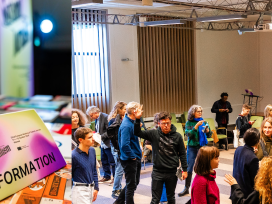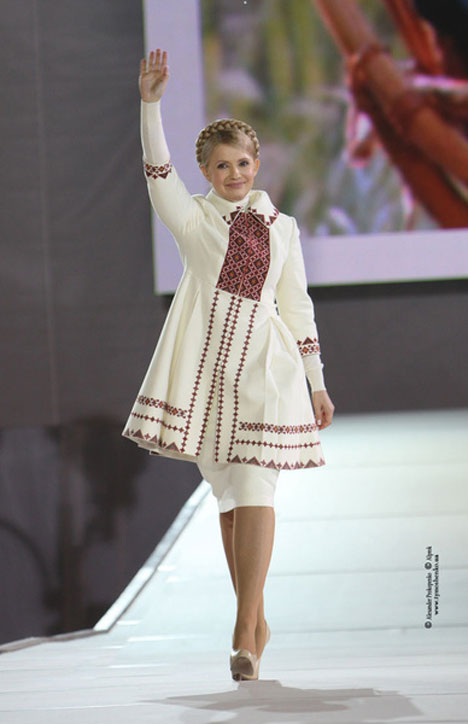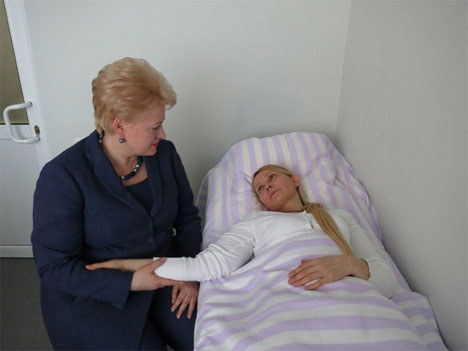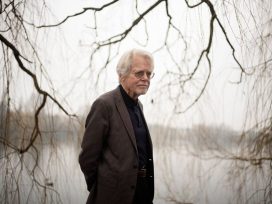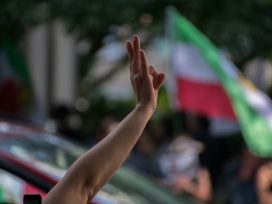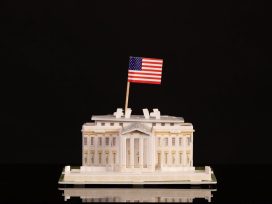The political phenomenon of Yulia Tymoshenko, her meteoric business career, her triumphant ascent to power and the consequent drama of her criminal prosecution and imprisonment are unique, even for turbulent, post-communist eastern Europe. Having started with a video rental shop at the end of the 1980s, she built a business empire using her husband’s family connections. Ten years later, in a move typical of Ukrainian tycoons seeking to protect their business interests, she entered politics. However, upon her election to the Ukrainian parliament, she joined the opposition to president Kuchma. Dismissed from her post of deputy prime minister in charge of energy policy in 2001, she faced a criminal case and spent 42 days in prison – a fact she later made use of in presenting herself as a victim of the Kuchma regime. In the 2004 presidential elections, Tymoshenko supported Viktor Yushchenko and became the female icon of the Orange Revolution. Her visual appearance from that period evoked a broad variety of cultural connotations: from Marianna of the Ukrainian revolution and a woman-warrior fighting the dark forces of evil to the traditional Mother of the Nation, the embodiment of chastity, tenderness and love. Tymoshenko’s golden plait, reminiscent of a nimbus or a crown, has become the most successful brand in Ukrainian politics since she appeared on the covers of glossy magazines and on TV screens. Styled as a political celebrity, she did not so much persuade as seduce both the Ukrainian and the international public.
Tymoshenko was appointed prime minister by Viktor Yushchenko, but dismissed seven months later as her political honeymoon with the president ended in the dramatic split of the Orange coalition. In 2007 she returned to the prime minister’s office and retained her position despite severely strained relations with the president. The conflict between them, which led to lasting deadlock in Ukrainian politics, threw democratic reforms into disarray. Competing with Viktor Yanukovych in the 2010 presidential elections, Tymoshenko lost by a very narrow margin. One year later she faced criminal charges for “abuse of office” linked to a natural gas imports contract signed with Russia in 2009 and, after two months of hearings, was arrested in the courtroom for “ridiculing court proceedings”. Finally, in October 2011, she was found guilty and sentenced to seven years in jail. In December 2011, Tymoshenko was re-arrested (while in prison) as part of a new investigation into alleged tax evasion and theft of public funds by the United Energy Systems of Ukraine, the company she chaired from 1995 to 1997. In January 2013, Tymoshenko was officially notified that she was suspected of ordering the murder of the Donetsk businessman Yevhen Shcherban and his wife in 1996.
Since her imprisonment, Tymoshenko’s case has polarized Ukrainian society and been closely followed in the West as an example of selective justice and political repression. While in prison, Tymoshenko went on hunger strike several times, protesting against her politically motivated prosecution and later against vote rigging during the October 2012 parliamentary elections. From the first weeks of her imprisonment she complained of her deteriorating health. Claiming to be immobilized by back pain, Tymoshenko refused to attend court proceedings and complained of physical abuse. Expressing concern for her life, she declined medical services offered by the Ukrainian penitentiary system and appealed to the West for an independent medical examination. In February 2012, three Canadian and two German doctors permitted to examine Tymoshenko stated that she was seriously ill and needed special medical treatment which could not be provided in the penal colony. While Tymoshenko’s supporters posted photos of her bruises on the Internet, the Ukrainian authorities organized leaks of internal surveillance videotapes showing the jailed opposition leader moving nimbly around her cell, despite claiming to be severely ill, and in a romantic embrace with her lawyer. The videotapes shown on national TV were dismissed by Tymoshenko as fake. In turn, her relatives and political allies appealed to the West, pointing to permanent video surveillance as a violation of privacy and a form of political persecution.
Thus, one can say that Tymoshenko’s body made a second appearance in Ukranian politics, this time as a convict. Her physical condition and health problems, her changing symptoms and controversial diagnoses are constantly discussed by Ukrainian and western medical experts, lawyers, politicians and journalists. Tymoshenko’s body has become a political battlefield: immobilized, closely watched and physically tortured, it embodies not only the state of the political opposition, but the general state of Ukrainian society: the whole Ukrainian nation captured by the “criminal regime” of President Yanukovych.
This essay is an intervention in post-Soviet politics and Ukraine’s dilemmas concerning democratization and European integration – from the perspective of the role of Yulia Tymoshenko’s body in Ukrainian politics. The metaphor of Tymoshenko’s two bodies can be understood in more than one sense: on the one hand, I differentiate between her physical and political (symbolic) body. On the other hand, I juxtapose “Tymoshenko-1” – the populist prime minister and political celebrity whose physical appearance was compatible with both the traditional values and the market-driven desires of Ukrainians –and “Tymoshenko-2” – the imprisoned leader of the political opposition whose immobilized and tortured body became a stage set for the drama of repressed Ukrainian democracy, performed first and foremost for western eyes.
The gendered body in the postmodern political spectacle
The title of this essay alludes to Ernst Kantorovich’s famous book The King’s Two Bodies. A medievalist, Kantorowicz argued that the king’s natural body had physical attributes, suffering and dying as any human being, while his other, spiritual body symbolized the monarchic power that transcended the earthly. This bodily dimension of power is no longer present in democratic politics, but reappears in authoritarian and totalitarian regimes. For example, the US anthropologist Alexei Yurchak argues in his account of the Soviet cult of Vladimir Lenin that the public display of Lenin’s preserved body in the mausoleum in Red Square played an important role in legitimizing the Soviet polity.
New studies on populism and political celebrities, however, point to the return of the body (male as well as female) and its symbolic dimension to modern politics. A collection of essays edited by Helena Goscilo demonstrates that the physical appearance of president Putin and careful staging contributed to his popularity, turning him into a cultural icon of the new Russian masculinity:
One of Putin’s innovations […] is associated with issues of male sexuality, which were never promoted in relation to the Father of the Nation in Russia before Putin assumed office. […] Putin has emerged as an example of fitness and health that both women and men find appealing. In some photos made readily available to the public gaze, Putin happily poses bare-chested, showcasing his well-developed musculature as a visual manifestation of virility.
If in the case of Putin these new tendencies can be attributed to an authoritarian cult of personality linked to the legacy of Russia’s Stalinist past, the same phenomenon in western democracies is usually explained with reference to the merging of politics and pop culture, which produces a new style of political communication:
The advertisement (and the conventions of advertising) come to define political communication. Politicians become stars, politics becomes a series of spectacles and the citizens become spectators.
Feminist political scientists point to the fact that the female body plays an ambivalent role in representations of women politicians. For example, Elza Ibroscheva and Maria Raicheva-Stover observe in their study of the 2005 parliamentary elections in Bulgaria that “press coverage of female politicians was refracted through the prism of gender stereotypes, which, in turn, exemplified the current trend of the post-communist masculinization of democracy”. According to their analysis, “politics is treated by the media as a male-oriented realm, where female politicians are either treated as novelty or framed within typical stereotypes of femininity.” However, this feminist critique focusing on misrepresentation of women and gender stereotypes fails to explain the high popularity that some female politicians enjoy, despite a rather masculine, and even sexist, political culture. In fact, certain female politicians profit from contemporary celebrity politics, as Yuliia Shulga argued in her study on Yulia Tymoshenko:
The female body can be used as a lucrative mode of conveying political representation, as its visual characteristics, such as clothes, looks and postures are generally characterized by a greater variety than those of men and therefore create more possibilities for political communication.
Tymoshenko-1: The glamorous body, political celebrity and populism in post-Soviet politics
As one of the leaders of the Orange Revolution and later as prime minister, Yulia Tymoshenko, with her capacity for self-fashioning and self-enactment, fascinated gender scholars as a political icon. Marian Rubchak was probably the first to observe that Tymoshenko, with her traditional plait, modelled herself according to Ukrainian nationalist cultural codes: she evoked the image of Berehynia, a pagan Slavic goddess, a hearth-mother today associated with the guardianship not only of the family, but also the nation. Rubchak argued that Tymoshenko successfully utilized the Ukrainian myth of matriarchal power deeply rooted in Ukrainian culture. However, use of ethnographic elements alone would never have made her a political celebrity in a post-Soviet country longing for global standards of consumption. Tymoshenko’s success lay in her particular blend of traditionalism and modernity, merging national archetypes with cosmopolitan clichés of the global fashion industry – high heels and a coat by Louis Vuitton combined with a traditional Ukrainian shawl and embroidery. Brian James Bayer calls this feature of post-Soviet self-fashioning bricolage – “a reflection of the post-revolutionary foment and semiotic chaos of post-Soviet society”.
According to Lviv feminist scholar Oksana Kis, Yulia Tymoshenko’s political success is based on her skilful combination of two predominant models of normative femininity in Ukraine – Berehynia and the Barbie doll, which correlate respectively to national and cosmopolitan varieties of femininity:
A woman interested in a political career in Ukraine is expected to fulfil at least two roles: as Berehynia she has to become a virtuous mother of her nation; as Barbie she must be a national sex symbol.
If Berehynia relates to the formerly forbidden ideology of Ukrainian nationalism, Barbie is a manifestation of western consumerism, the embodiment of market-driven desires for beauty and fashion. From a feminist perspective, however, both rigid role models place limitations on the political performance of a female politician, who has “to serve – either a man or a patriarchal nation-state”.
Indeed, in contrast to western female politicians such as Angela Merkel or Hillary Clinton, Yulia Tymoshenko’s image has been aggressively feminine. Natalia Matamoros makes a direct comparison between the highly conformist business style of Hillary Clinton and Tymoshenko’s approach:
The number of elements decorating her clothes is amazing, as well as the selection of exquisite fabric and colours. Tymoshenko’s style is “conspicuously not masculine”, her “difference to men is strongly signalled” by numerous hyper-feminine details of her clothing. Even her strict military looking jacket […] will always be coupled with a skirt and never trousers.
However, this “conspicuous femininity” does not necessary signal subjugation to the male political world. Instead, Tymoshenko’s visual appearance corresponds to her style of political communication, which appeals to feelings and emotions rather than rational arguments. Its aim is seduction rather than persuasion. Not by chance, the abbreviation of her political force, Block of Yulia Tymoshenko (BYUT), hints strongly at the word “beauty”, a word used in one of her electoral slogans, in which she borrowed Fyodor Dostoyevsky’s often misunderstood phrase, “Beauty will save the world!”
“Beauty” is of course a social and cultural construct. In the Russian classical tradition (which was maintained to some extent in Soviet literature too), female beauty is usually an expression of a rich inner world and spiritual qualities, a result of internal evolution – in which suffering has often played a role. Tymoshenko, who referred to her martyrdom at the hands of Kuchma’s regime in 2001, was fully aware of this cultural pattern. Her transformation from “an ill, pale and exhausted woman – a sacred martyr, a victim of injustice […] into a powerful, determined, beautiful cosmopolitan woman” corresponded to it. Her beauty came to be seen as proof of her inner moral qualities, of her chastity and spiritual purity, signifying her opposition to the corrupt regime and to the dirty world of male politics.
At the same time, “beauty” in post-Soviet Ukraine speaks the language of glamour. According to Helena Goscilo and Vlad Strukov, glamour in Russia (and in the post-Soviet space) is about more than just conspicuous consumption among the “new rich”:
The by-product of consumption culture, glamour in Russia is a new utopia, having replaced both the late Soviet project of building a radiant future and the early-1990’s vision of a democratic state. Not just an ephemeral vagary of the economic scene, glamour is an ideal of a social structure promulgated and promoted by Putin’s regime. Like Soviet projects, the glamour utopia nurtures the aim of constructing a new being – homo glamuricus, to replace homo sovieticus – of building a new middle class, with its standard bourgeois ideology and taste.
Tymoshenko’s glamorous body is certainly bound up with the none-too-deep roots of the Ukrainian political class, which emerged overnight on the ruins of the Soviet economy and secured its high social status with its dubiously accumulated wealth. In post-Soviet Ukraine, glamour has become a form of social distinction (Bourdieu) that provides the new social hierarchy with its stamp of legitimacy. Moreover, the omnipresence of a culture of glamour and conspicuous consumption among the Ukrainian political class signals its organic ties to the oligarchy. To put it more bluntly, glamour is the pseudo-ideology of the “captured state” sometimes referred as “Ukraine Ltd.” It attests to the absence of politics in the Weberian sense – as an autonomous sphere of professional political activity.
But glamour, as noted above by Goscilo and Strukov, is not just a culture of the wealthy – it is a popular utopia, and as a new utopia it is linked to post-Soviet populism, the only incarnation of democracy available to Ukrainians after the collapse of the Soviet Union. Populism is a dirty word in the West signifying the decadence of representative democracy. From a post-Soviet perspective, however, populism can be seen as a first step towards democracy, as Francisco Panizza reminds us:
Populism is not just about the crisis of representation in which people are weaned off their old identities and embrace a new “popular” one. It is also about the beginning of representation, allowing those who have never been represented because of their class, religion, ethnicity or geographic location, to be acknowledged as political actors.
The Orange Revolution in Ukraine was a popular movement that gave many people the feeling of empowerment but failed to achieve its goals in the absence of stable democratic institutions and instruments of public control over politics. Political competition and media freedom were not enough to defeat corruption and, without fully functional democratic institutions, political reforms lost out to populism.
Yulia Tymoshenko was often called “the queen of Ukrainian populism”. Her brand of populism – that of a glamorous princess – differed, however, from its classical versions where “identification is strengthened by the leader’s adoption of cultural elements that are considered markers of inferiority by the dominant culture”. Promising social justice, love and care to everybody, embracing the elderly and the poor, Tymoshenko appeared as a beautiful stylish lady who did not even try to hide the value of her designer clothes. In fact, her glamorous political body took centre stage in the populist spectacle of the Orange Revolution. How can a populist politician wear Louis Vuitton in a country where the average wage is less than a hundred dollars per month? This was a question that western journalists frequently asked. The answer is simple: glamour as the “opium of the people” has become integral to post-Soviet populist politics.
Tymoshenko-2: The tortured body, immobilized opposition and Ukraine’s defective democracy
In May 2011, one year after losing the presidential elections to Viktor Yanukovych, Tymoshenko was charged with “abuse of office” and, in August the same year, arrested in the courtroom. Criminal cases were also brought against a dozen former officials from the Tymoshenko government, a campaign presented by president Yanukovych as a “battle against corruption” but seen by the Ukrainian opposition as “political persecution”. Soon after her arrest, Tymoshenko complained of multiple haematomas and demanded her personal doctor perform blood tests; some BYUT deputies raised concerns that she might have been poisoned, like Viktor Yushchenko in 2004. Some weeks later, Tymoshenko started to suffer from severe back pain; medical tests in a private Kyiv clinic revealed spinal disc herniation. Claiming to be immobilized by pain, Tymoshenko refused to attend court proceedings and complained of physical abuse. Faced with Tymoshenko’s boycott on medical grounds, the authorities made tactical mistakes that dealt a serious blow to the president’s image. For example, on 8 December 2011, court hearings took place in her cell, where Tymoshenko lay in bed unable to move and heavily anaesthetized; this was seen by the many Ukrainian and international observers as a severe abuse of human rights.
Tymoshenko’s physical and moral suffering in prison (without doubt not faked) was presented by the Ukrainian opposition as torture carried out at the behest of president Yanukovych, who was motivated by personal revenge. While the president publically promised that Tymoshenko would receive medical treatment that “met with European standards”, her attorney Serhii Vlasenko expressed deep concern about her security, arguing that “Yanukovych does not need her alive”. That Tymoshenko’s martyrdom was the centre of media attention had a tremendous mobilizing effect during the first months of her imprisonment – thousands of demonstrators regularly gathered on the streets of Kyiv to support the imprisoned opposition leader. On 27 November, Tymoshenko’s birthday, prayers for her health were held in the Greek Catholic and Orthodox churches of the Kyiv Patriarchy all over the country. In December 2011, BYUT deputies blockaded the Ukrainian parliament under the banner “Yanukovych, don’t kill Yulia!”, demanding their leader’s release.
On 30 December 2011, Tymoshenko was transferred to Kachanivska penal colony in Kharkiv, an east Ukrainian city at the border with Russia. One of the motives of the Ukrainian authorities was to move her away from Kyiv, where she was not only the centre of media attention but had significant popular support and could be visited by foreign diplomats. As a means of recapturing fading attention, Tymoshenko responded to this move by focussing even more on her dramatic health condition and physical abuse. She declined the medical assistance that the Ukrainian penitentiary service offered and demanded an independent medical examination. In February 2012, three Canadian and two German doctors permitted to examine Tymoshenko stated that she was “ill, in constant pain and requires toxicology and other laboratory testing”. As a new process focusing on the alleged misappropriation of government funds by United Energy Systems of Ukraine commenced in April 2012 in Kharkiv, she refused to attend on the grounds of poor health. Using her health as a pretext for boycotting court proceedings at the same time as systematically declining medical treatment, Tymoshenko turned her body into a political weapon and effectively sabotaged the plans of her political enemies.
On 19 April 2012, Tymoshenko was moved against her will from Kachanivska prison to a Kharkiv hospital, where she embarked on a hunger strike in protest at the violence and physical abuse she had suffered. A couple of days later, the Ukrainian ombudsman Nina Karpachova visited Tymoshenko in hospital and documented haematomas on her stomach and arms that had resulted from physical abuse. Photos of Tymoshenko’s bruises appeared in Ukrainian and international media and caused huge international outrage; in Ukraine, critical journalists perceived the “beating of Yulia Tymoshenko” as crossing the red line and a sign of the ruling regime’s by now obvious moral degradation. President Yanukovych once again suffered a blow to his image. In May 2012 new photos of the suffering and immobilized Tymoshenko, skinny and pale after her hunger strike, appeared on the Internet, taken during the visit of Lithuanian president Dalia Grybauskaite to the Kharkiv hospital.
The Yanukovych regime has responded to Tymoshenko turning her body into a political weapon with rather predictable tactics. The Ukrainian penitentiary system and the pro-presidential media denied the existence of her health problems and the facts of her physical abuse; moreover, they tried to compromise Tymoshenko by presenting her stay in the penal colony and later in hospital as luxurious holidays that most Ukrainians could never afford. The special status of Tymoshenko as a glamorous convict, a celebrity who enjoys public attention, receives visitors every day and can continue her luxurious lifestyle even in prison was thematized in a cartoon, where she appears enjoying a sauna, a fitness session and even taking drugs while other female inmates are hard at work.
Turning Tymoshenko’s celebrity image and her “glamorous body” against her, her political enemies peddled a politics of envy and schadenfreude. Tired of Tymoshenko’s case and irritated by the permanent discussion of her complaints in the media, a significant section of the Ukrainian public lost sympathy with her. In April 2012, an interview with Tymoshenko’s former room-mate appeared in the Ukrainian media, which revealed the details of their everyday routine in the penal colony. According to Yulia Abaplova, Tymoshenko was continually provided with medical care, she was able to sit at the table and work for several hours per day and did some fitness exercises too. They both enjoyed all kinds of delicious food that Tymoshenko received from her relatives and supporters. This interview was denounced by both Tymoshenko and her lawyer; according to Tymoshenko, her room-mate was blackmailed, put under psychological pressure and forced to give false information. Tymoshenko’s attorney Serhii Vlasenko published a letter allegedly written by Abaplova in March 2012 where she had admitted pressure from the penal colony administration and raised concerns about Tymoshenko’s security. Abaplova responded by saying that her letter was dictated by Tymoshenko.
Another PR operation undertaken by the Ukrainian authorities in April 2012 involved leaking a surveillance video containing scenes of Yulia Tymoshenko in Kyiv prison in December 2011. The video shows Yulia moving around her cell wearing high heels despite having claimed to be in severe pain; at the end of the tape, Tymoshenko gives her attorney Serhii Vlasenko a long romantic hug. The video tape was dismissed by both Tymoshenko and Vlasenko as a fake. Another leaked video showing Tymoshenko moving around her hospital room and during fitness exercises appeared on the Internet in October 2012 and again was dismissed as a fake and a provocation.
The problem of video surveillance became the subject of the next battle to animate Ukrainian political life for many months. Tymoshenko complained about her room being lit round the clock by electric light and the extensive use of video cameras, which she and her supporters described as “torture”. Tymoshenko argued that video cameras, especially those in the shower cabin and in the toilet, violated her privacy and intruded on her intimate sphere. The representatives of the state penitentiary service first denied the existence of video cameras, but later claimed that cameras were installed “to protect Tymoshenko’s health and life”.
Clearly, video surveillance was one of the few means of psychological pressure left to the Yanukovych regime with regard to Tymoshenko, not only because every woman would feel humiliated and abused by the voyeuristic gaze of a (male) overseer, but also because videotaping provided authorities with the rich material for their PR operation intended to discredit the opposition leader. Yet, with criminal prosecution, imprisonment and exclusion from official politics, Tymoshenko’s body has gained even more symbolic weight: immobilized, closely watched, tortured, it represents the state of the political opposition in today’s Ukraine. Under permanent video surveillance, she is an object of panoptical control, which itself has obviously been used as a means of punishment. But if according to Foucault the panoptical model came to replace the spectacle of public corporal punishment, then in postmodern populist politics, panoptical surveillance itself has become part of the political spectacle. As a particularly perverted case of a “mediated voyeurism”, the Ukrainian public was invited to peep at the former prime minister and the leader of the opposition, watch her in her private sphere and make judgements about her health and physical condition that supported the view that her illness was faked.
In January 2013, Tymoshenko once again went on hunger strike and refused to enter her room until the video surveillance equipment was removed. She warned that from now on she refused to cooperate with the state penitentiary system and would attend court only if physically forced. In an open letter, Tymoshenko creatively turned her being an object of male voyeurism to her moral advantage, implying that watching his defeated and imprisoned political enemy gave President Yanukovych some sort of perverse satisfaction:
From this moment on, I am not going to subdue to your bulling and humiliation. I will not allow anymore searching me or my belongings. I will defend myself with all the physical force I have, as far as I can. I am not going to enter my room before you, Viktor Fedorovych, remove your video cameras, which you use to pry into my bed, my shower cabin, my toilet, to watch how I undress, eat, sleep, speak to my doctors and lawyers. I wonder if your sons, Oleksandr and Viktor, share this male hobby with you, Viktor Fedorovych.
A few days prior to the EU-Ukraine summit in March 2013, during his “Dialogue with Ukraine” television campaign, Viktor Yanukovych “recommended” that the state penitentiary service remove the video cameras in Yulia Tymoshenko’s hospital room. The same day, the penitentiary service announced that the cameras had been dismantled.
While Tymoshenko’s strategy of politicizing her convict body and turning it into a site of personal resistance allowed her to retain the public’s attention for one-and-a-half years, this partial success has taken its toll. The trivialization of her body carries with it the serious danger of her “desacralization” as a political leader, as the following comment illustrates:
What is Tymoshenko’s real tragedy? The problem is her team are dolts! With this permanent show about Tymoshenko’s suffering in prison they turned her from a national leader into an alternative heroine of “Dom-2”. A national leader must have a political goal and be able to lead to it. Instead, every day we are fed with all these embarrassing details about syringes, pads, soap and so on. This, and not the authorities, ruins her as a leader. […] These dolts do not understand that politics is all about mystery and authority. If a politician appears as an ordinary person, if she behaves as an ordinary person, what should people feel about such a politician?
Under western eyes
The political spectacle of Yulia Tymoshenko’s imprisonment, as well as that of the Orange Revolution some years before, cannot be understood without taking their global dimensions into account. Ukraine, whose geopolitical future remains unclear, is torn between east and west, between post-Soviet Russia and the enlarged European Union. The Orange Revolution raised hopes of democratic reforms and integrating Ukraine into Europe. Though these hopes remain unfulfilled, the EU is still interested in closer cooperation with its eastern neighbour. The Association Agreement has been the subject of extended negotiations over a period of several years. Intended to usher in the Deep and Comprehensive Free Trade Area between Ukraine and the EU, closing the Agreement would bring President Yanukovych significant political dividends and improve his image abroad. But the political prosecution of the Ukrainian opposition remains the main stumbling block in the process. European officials have denounced the Ukrainian leadership’s “selective justice” and made the signing of the agreement conditional on Tymoshenko’s release. In summer 2012, after the international scandal surrounding the “beating of Tymoshenko”, some European politicians including Angela Merkel called for a boycott of the European football championship in Ukraine. As the first sign of the kind of concrete sanctions against Ukrainian officials that may be still to come, in October 2012 the five year US visa of the First Deputy Prosecutor General of Ukraine Renat Kuzmin was cancelled without explanation.
All the Ukrainian actors in this drama are of course aware of playing their roles “under western eyes”. Yulia Tymoshenko, as a popular Ukrainian politician with a strong pro-European and pro-democratic image, has repeatedly called on the West for moral and political support in her desperate fight with Yanukovych. Identifying her imprisoned and tortured body with the Ukrainian nation captured and humiliated by the “criminal regime”, she has appealed to “Europe” as a moral arbiter and legal authority while painting Yanukovych and his politics as non- and even anti-European: “Because of you, Ukraine has almost lost its chance to become a European state,” wrote Tymoshenko in the first lines of her open letter. Tymoshenko’s victim status in the West, and the political and moral support she has received from western leaders, constitute crucial symbolic capital and, in fact, the only advantage she has over her mighty enemy. However, this symbolic capital might easily evaporate if her image as a martyr is damaged: by accusing her of a contract murder, her persecutors intend to clinch the political end of Tymoshenko, as they imagine it would be perceived in the eyes of the West. Yulia Tymoshenko, an imprisoned opposition leader and a former political celebrity, cannot control the script now dictated by the presidential administration. At the same time, the “show must go on”, for this is her only hope of not being forgotten in Ukraine and in the West, and of returning one day to Ukrainian politics.
The irony of president Yanukovych’s politics of surveillance used to “discipline and punish” his political enemy is that he himself has been closely watched by the western media and political leaders. Under great pressure, he faces a difficult dilemma: to comply with western demands and release a dangerous political opponent who might defeat him in the coming 2015 presidential elections; or to sacrifice the Association Agreement and face the risk of international isolation and even incurring political sanctions. According to the Ukrainian political scientist Serhiy Kudelia:
The failure of western governments to achieve their goals in Tymoshenko’s case […] shows that even when the EU clearly demands and credibly commits itself to withholding substantial long-term benefits, the leadership of a target country may ignore them because of major domestic costs of compliance. […] If Yanukovych agreed to decriminalize Tymoshenko’s alleged offense and allowed her to participate in the 2012 parliamentary election, he would have shown his vulnerability to external pressure, revitalized the political opposition, and acquired a dangerous rival down the road.
As the final deadline for signing the EU-Ukraine Association Agreement approaches (there are still hopes that the Agreement will be signed at the Eastern Partnership Summit in Vilnius in November 2013), suspense grows. The recent release of Yuri Lutsenko, the former minister of interior in Tymoshenko’s government and her political ally, raised hopes for Tymoshenko’s pardon among her supporters. On 29 April, the European Court of Human Rights in Strasbourg ruled that Tymoshenko’s arrest during the 2011 trial was illegal and politically motivated, providing her and her supporters with some long awaited good news. But the court rejected Tymoshenko’s claim that conditions in prison were inhumane and degrading: lack of daylight, poor water quality, and lack of heating might have been problematic for her, but they weren’t serious. The court also “rejected her complaint about 24-hour video surveillance because she had not exhausted the Ukrainian legal system before turning to Strasbourg”. The court was not able to determine for sure whether she had been physically abused when she was transferred to a hospital in April 2012, because Tymoshenko had refused medical examination at the time.
